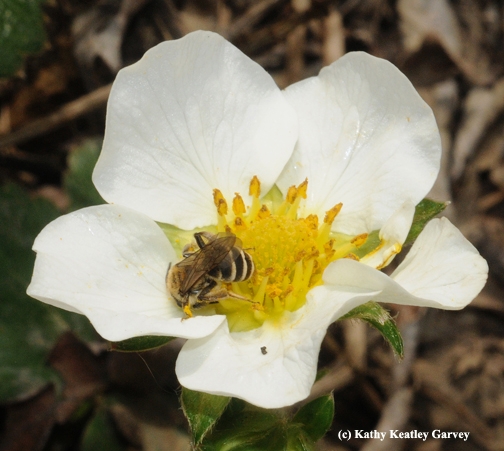
It was not long after Robbin Thorp's talk on wild bees at the UC Davis Pollinator Gardening Workshop (hosted by the California Center for Urban Horticulture on March 15 at Giedt Hall), that lo and bee-hold: a mining bee appeared in our backyard.
From the family Andrenidae, it was foraging on the cherry laurels (Prunus caroliniana). Thorp, a native pollinator specialist and emeritus professor of entomology at UC Davis, identified the bee from photos as genus Andrena, probably Andrena cerasifolii. "Note the pollen transport hairs on the hind legs," he said.
In his talk, Thorp mentioned that "there are more than 19,500 named bee species in the world, but more likely 20,000 to maybe 30,000." Of that number, North America has about 4500 bee species; California, 1600; and Yolo County, more than 300.
Indeed, Thorp has detected more than 80 bee species alone in the Häagen-Dazs Honey Bee Haven on Bee Biology Road, UC Davis (Yolo County). Planted in the fall of 2009, it's owned and maintained by the UC Davis Department of Entomology and Nematology.
Here are a few bees you might want to pursue:
Andrenidae (mining bees)
Halictidae (sweat bees)
Colletidae (polyester and masked bees)
Megachilidae (leafcutting, carder and mason bees)
Apidae (digger, carpenter, cuckoo and honey bees)
We're looking forward to "California Bees and Blooms: A Guide for Gardeners and Naturalists," to be published in the fall of 2014 by Heyday Press. It's the work of Gordon Frankie of UC Berkeley; Robbin Thorp of UC Davis; photographer Rollin Coville of the Bay Area; and Barbara Ertter of UC Berkeley. It will contain nearly 30 of the most common bee genera in California.
Frankie, Thorp, Coville and Ertter (and others) also published "Native Bees Are a Rich Natural Resource in Urban California Gardens" in California Agriculture.
Meanwhile, check out the UC Berkeley Urban Bee Lab website for interesting information on native bees.
You, too, can attract them to your yard. As Thorp says: "Plant them and they will come. Provide habitat and they will stay and reproduce."
Attached Images:
